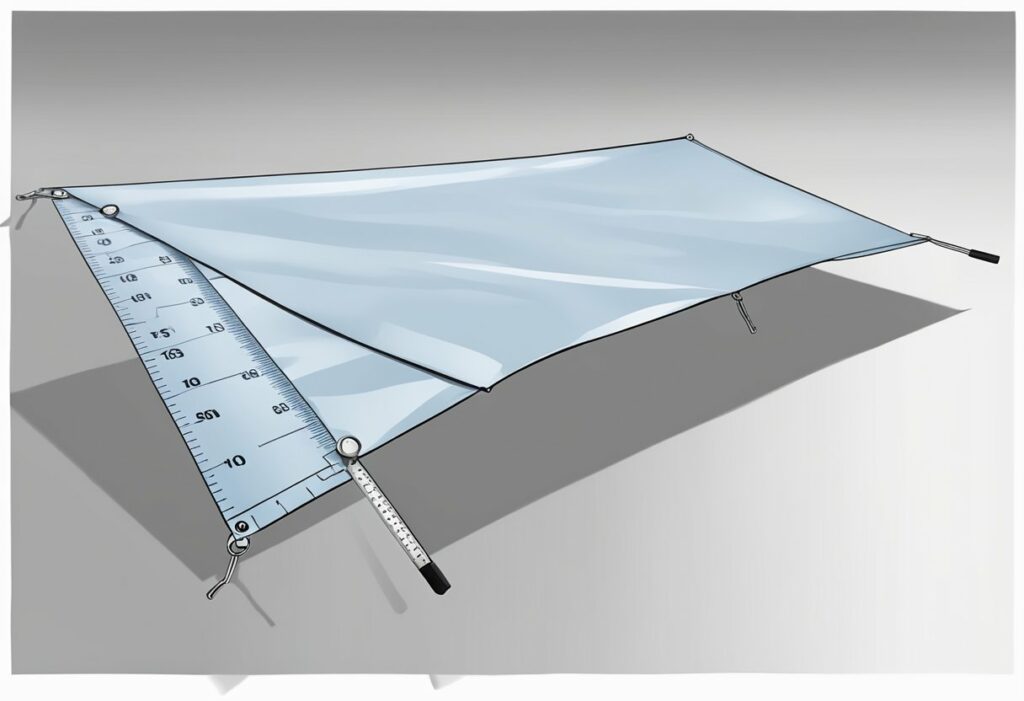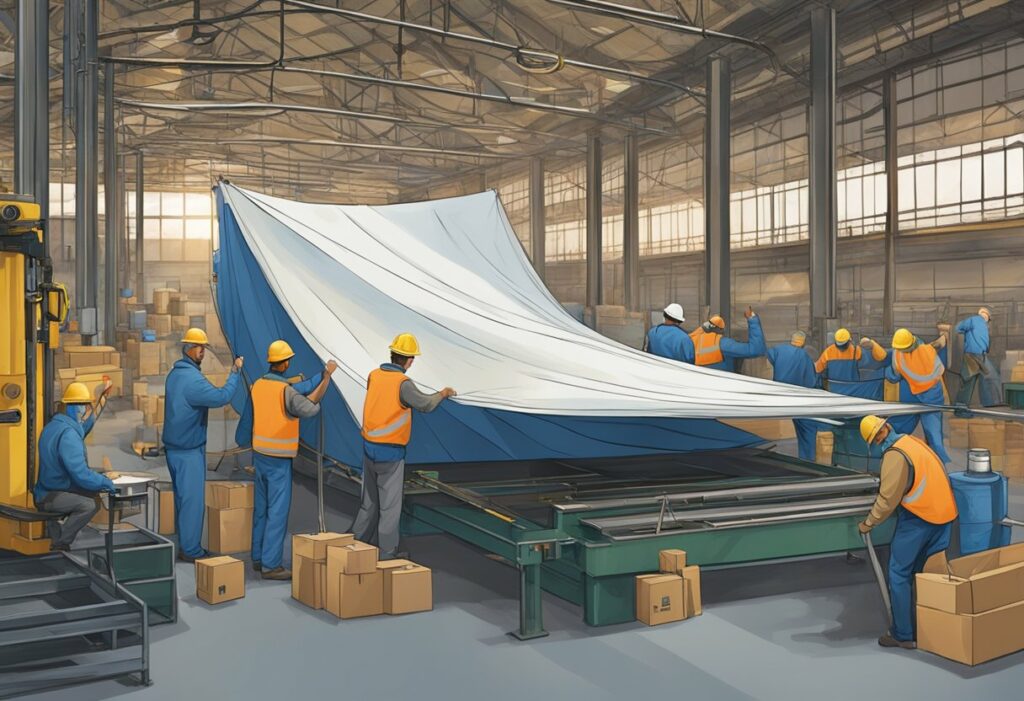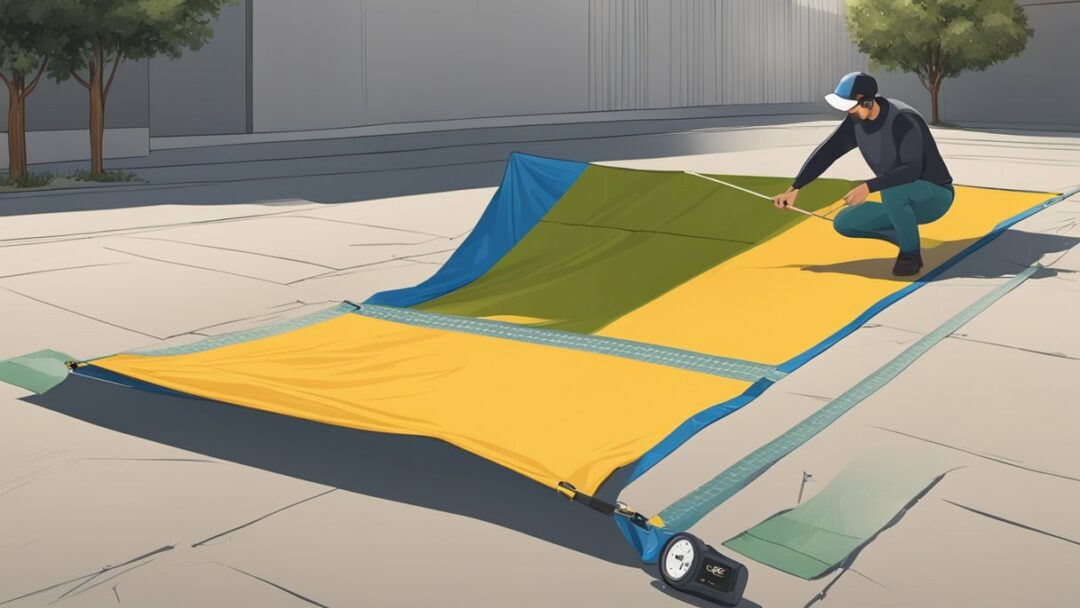A tarp, short for tarpaulin, is a versatile item used in various situations, including construction, painting, camping, and more. Its primary function is to serve as a protective covering for various surfaces and objects, shielding them against the elements, such as rain, wind, and sunlight. The price of a tarp depends on several factors, including size, material, and quality.
Tarps come in a range of materials, such as polyethylene, canvas, and vinyl, each with its specific uses and durability levels. Polyethylene tarps are usually found in commercial and residential applications, while canvas tarps are known for their breathability and natural resistance to water. Vinyl tarps, known for their strength and flexibility, are often used in heavy-duty applications, like truck coverings and industrial usage. By understanding your needs and the most suitable material for your specific situation, you can identify the appropriate tarp and its cost more efficiently.
The size of the tarp affects its price. Smaller tarps typically cost less, while larger ones come with a higher price tag. It’s also essential to factor in the thickness, weight, and quality of the materials to determine the overall cost of the tarp.
Key Takeaways
- Tarps are versatile protective coverings with diverse applications, and their price varies depending on factors like size, material, and quality.
- Polyethylene, canvas, and vinyl are common tarp materials, each with its unique properties and suitability for different purposes.
- Understanding your specific needs and requirements helps in selecting the most appropriate tarp and, consequently, its cost.
Understanding Tarps
Types and Options
There are various types of tarps available to suit different purposes. Some common types include:
- Canvas Tarps: Ideal for outdoor use, offering good breathability and water resistance.
- Poly Tarps: Versatile and affordable, often used for temporary coverings or protection.
- Hay Tarps: Specifically designed to shield hay bales from moisture to prevent rot or mold.
- Heavy-Duty PVC Tarps: Designed for prolonged exposure to the elements, offering both durability and weather resistance.
Material and Durability
Tarps can be made from different materials, which affect their durability and resistance to rot. Common materials include:
- Polyethylene: Often used in poly tarps, it is lightweight, water-resistant, and relatively inexpensive.
- Canvas: Made from cotton, canvas tarps are breathable, reducing condensation while still providing weather resistance.
- PVC (Polyvinyl Chloride): Known for its strength, PVC tarps are popular for heavy-duty applications and offer excellent weather resistance.
Tarp durability is also influenced by its thickness and weight. The thickness of a tarp is measured in mils (1 mil = 1/1,000 of an inch). Thicker tarps provide higher durability, with heavy-duty tarps usually having a thickness of 20 mils or more. The weight of a tarp, listed in ounces per square yard, can also be an indicator of its quality and toughness.
Sizing Considerations
When selecting a tarp, sizing is an important factor to consider. Tarps can come in numerous sizes, and selecting the right one depends on your specific needs. Keep the following points in mind:
- Cut Size: The original size of the tarp before any seams or hems are folded and sewn. This is larger than the actual usable size.
- Finished Size: The final size of the tarp after the seams and hems are sewn in. This will be slightly smaller than the cut size.
To ensure that the tarp you choose fits your intended use, make sure to account for the difference between cut size and finished size. Additionally, consider the overlaps or additional coverage you may need for your application.

Practical Uses of Tarps
Protection and Covering
Tarps are versatile, providing many practical uses for both residential and commercial needs. One of the most common uses for tarps is protection and covering. They are excellent for covering and protecting various types of cargo in the transportation industry. This can include anything from steel and lumber to irregularly shaped items. Poly tarps, canvas drop cloths, vinyl tarps, and mesh tarps are useful for collecting and transporting yard waste, such as grass clippings, leaves, and garden debris, making yard work more manageable.
Camping and Outdoor Activities
When it comes to camping and outdoor activities, tarps play a significant role. They can be used as simple bivvy shelters, offering protection from the elements during hiking and camping trips. Additionally, they can provide shade and privacy for outdoor showers and toilets, making them essential for campers and outdoor enthusiasts.
Here are some popular camping and outdoor uses for tarps:
- Bivvy shelters
- Groundsheet
- Covering equipment and gear
- Hammock rain fly
- Shade canopy
- Windbreak
Specialty Tarps
There is a wide range of specialty tarps available, designed for specific applications. For example, camo tarps are popular among hunters and outdoor enthusiasts, as they blend well with the natural environment and are effective for concealing equipment or creating hunting blinds. Heavy-duty PVC vinyl tarps are more expensive but suitable for large-scale coverings, such as industrial equipment or commercial storage.
In summary, tarps are a valuable tool for numerous situations, from coverings and protection to camping and specialty applications. Their versatility and affordability make them a must-have item for home, outdoor, and commercial use.
Selecting the Right Tarp
Factors to Consider
When choosing a tarp, it’s essential to consider factors such as size, material, and purpose. Tarps come in various materials like canvas, vinyl, and poly tarps, each serving unique needs and applications.
- Canvas Tarps are made from duck cotton or polyester fibers, which offer durability and breathability. Ideal for outdoor applications, these tarps protect against mildew and water, but may not be as heavy-duty as other materials.
- Vinyl Tarps provide excellent waterproofing and resistance to abrasions, tears, and UV rays. They are suited for demanding conditions and long-term use.
- Poly Tarps offer versatility and affordability, making them popular for recreational and commercial uses.
Waterproofing and Resistance
A key aspect to consider when purchasing a tarp is its level of waterproofing and resistance to various elements. The material you choose will greatly affect its protective capabilities:
- Waterproof: Vinyl tarps provide the best waterproofing, followed by poly tarps. Canvas tarps offer water resistance but may not be completely waterproof without additional treatment.
- UV Resistance: Vinyl tarps offer excellent UV resistance, whereas poly tarps and treated canvas tarps provide moderate protection from the sun.
- Mildew and Rot Resistance: Canvas tarps provide natural resistance to mildew and rot, while vinyl and poly tarps require additional treatments to offer similar protection.
Product Reviews and Recommendations
Before making your final decision, consult product reviews and recommendations to determine the quality and durability of different tarp options. Whether you’re looking for a tarp for construction, recreation, or emergencies, reviews play a crucial role in helping you make an informed choice.
When reading reviews, pay attention to factors such as:
- Quality and thickness of the tarp material
- Ease of installation and use
- Overall durability and ability to withstand harsh weather conditions
Keep in mind that your specific needs will determine which tarp is best-suited for your situation. No single tarp is universally perfect for all applications, so weigh the pros and cons of each option before making a purchase.
Tarp Care and Maintenance
Preventing Rot and Damage
To ensure the longevity of your tarp and prevent rot, it is essential to choose the right material for your needs. Tarps made from polyethylene or PVC vinyl materials tend to be waterproof and resist mildew, making them suitable for outdoor usage. When using tarps, avoid exposing them to conditions beyond their designed purpose, as this may cause damage or accelerate wear. For instance, if your tarp is not UV-resistant, prolonged exposure to sunlight could weaken the fabric and compromise its integrity.
Regular inspection is crucial in identifying potential damage, such as tears, holes, or fraying edges. Detecting and resolving issues early can help extend the lifespan of your tarp. If you notice any damage, consider using a tarp repair kit or tape to mend the affected area promptly.
Cleaning and Storage
Maintaining the cleanliness of your tarp is essential in preventing rot and preserving its waterproof properties. Follow these simple steps to clean your tarp effectively:
- Shake off any loose debris or dirt.
- Use a soft brush or sponge to gently scrub the surface, using mild soap and water.
- Rinse the tarp thoroughly to remove soap and grime.
- Air dry the tarp completely before storing it.
Proper storage plays a key role in preserving your tarp’s condition. Tarps should be stored in a cool, dry place, away from direct sunlight and heat sources. To prevent the formation of mold or mildew, ensure that your tarp is completely dry before folding it for storage. It is also a good practice to keep your tarp off the ground and employ a storage container or bag to protect it from dust, insects, and moisture during storage.
By adhering to these guidelines for tarp care and maintenance, you can prolong your tarp’s lifespan and preserve its waterproof capabilities.

Purchasing Tarps
Where to Buy
Tarps can be purchased from a variety of sources, including home improvement stores like Home Depot, as well as other retailers such as Lowe’s. Additionally, specialized stores like Tarps Now offer custom-sized and heavy-duty tarps, with over 30 years of dedication to quality and service. Online marketplaces also provide options, with popular sites like Amazon and eBay listing a wide range of tarps for different needs and applications.
Price Comparisons and Local Store Prices
When shopping for tarps, it’s essential to compare prices across different sources. Here’s a general breakdown of price ranges for common types of tarps:
- Blue poly tarps: under $20 to over $140, depending on dimensions
- Woodpile tarps: around $20 to $40
- Heavy-duty PVC vinyl tarps: under $50 to nearly $570 for large options (e.g., 40’x40′)
Keep in mind that these price ranges may vary depending on the retailer, brand, and quality of the tarp. It’s always a good idea to check local store prices for more accurate cost estimates, as online prices may not reflect location-specific discounts or promotions.
Shipping and Delivery
When ordering tarps online, be sure to consider shipping and delivery fees and timeframes. Many retailers offer standard, expedited, or two-day delivery options for tarp purchases. Shipping times and costs will vary depending on the retailer and the specific product being purchased.
For example, Amazon Prime members can often expect free two-day shipping for eligible products, while other retailers may require a minimum purchase or charge additional fees for faster shipping. In-store pickup is a cost-saving and time-effective alternative to shipping, with retailers like Home Depot and Lowe’s offering free in-store pickup for online orders that can be ready within a few hours.
By considering these important factors – where to buy, price comparisons and local store prices, and shipping and delivery options – you can confidently purchase the right tarp for your needs and budget.
Customer Support and Services
Contacting Retailers
When purchasing a tarp, it’s essential to have easy access to customer support for any queries or concerns. Many retailers offer multiple ways to contact them, including phone, email, and live chat. For example, Tarps Now provides a toll-free phone number (888-800-1383) and an email address: [email protected] A screen reader can help visually impaired users to access these details.
Resolving Issues with Orders
In case of any issues with your tarp order, such as incorrect size, damaged product, or shipping delays, it’s crucial to reach out to the retailer’s customer support promptly. They can assist in resolving issues by offering:
- A refund or exchange for damaged or incorrect items
- Information on order status or estimated arrival time
- Guidance on selecting the right tarp size or material
Taking the time to read and understand the retailer’s shipping and return policies can also help ensure a smooth transaction.
Understanding Terms of Use
Before making a purchase, it’s important to review the retailer’s Terms of Use. These terms often include vital information about payment methods, shipping policies, returns and refunds, and warranties. By thoroughly understanding these details, customers can ensure they’re fully aware of their rights and responsibilities as purchasers.
Keep key points in mind, such as:
- Payment options (credit cards, PayPal, etc.)
- Shipping times and costs
- Return and exchange policies
- Warranties or guarantees
In summary, accessing and understanding customer support options, addressing any issues with orders, and acquainting oneself with the Terms of Use are essential steps when purchasing a tarp.
Online Resources and Tools
Digital Tarp Guides and Calculators
When shopping for a tarp, it’s essential to know the different types, materials, and the appropriate size you’ll need. There are several online guides and calculators that can assist you in choosing the right tarp for your specific needs. Websites like Xpose Safety offer comprehensive guides that explain various tarp materials, their uses, and advantages.
In addition to guides, some websites provide handy calculators to help determine the correct tarp size based on the dimensions of the item you want to cover. To use these calculators, you simply input the measurements, and the tool will provide a recommended tarp size. Ensuring you have the proper tarp size will contribute to better performance and longevity of the tarp.
Navigating E-commerce Platforms
Various e-commerce platforms offer tarps for sale. Platforms like Harbor Freight, Ace Hardware, and Tractor Supply Co. provide a wide selection of tarps in various sizes, materials, and prices. Here are some price ranges you can expect when browsing on these platforms:
| Platform | Price Range |
|---|---|
| Harbor Freight | $10 – $100 |
| Ace Hardware | $25 – $500 |
| Tractor Supply | Varies by store |
When navigating e-commerce platforms, be aware of the different tarp classifications such as light duty, medium duty, and heavy duty. Light-duty tarps typically cost less and are suitable for temporary, indoor, or mild-weather applications. Medium-duty tarps offer better durability and are suitable for more extended use or moderate weather conditions. Heavy-duty tarps are the most robust and long-lasting, ideal for professional applications and harsh weather.
It’s important to read customer reviews on these platforms to gauge the quality and reliability of the tarps you are considering. This will give you a better understanding of how well the tarps have served others in similar situations.
By using digital tarp guides, and calculators, and familiarizing yourself with the various e-commerce platforms, you’ll be better equipped to make an informed decision when purchasing a tarp. Keep your specific needs and budget in mind when selecting the best tarp for your project.

Industry and Usage
Construction and Commercial Use
Tarps are versatile tools commonly used in the construction and commercial industries due to their durability and cost-effectiveness. They are typically made from materials such as canvas, vinyl, clear vinyl, polyethylene, and mesh. These materials offer varying degrees of water resistance, strength, and longevity.
In the construction industry, tarps serve a variety of purposes, which include covering supplies, equipment, and unfinished structures. For example, heavy-duty tarps with a thickness of 20 mils or more provide excellent protection against harsh weather conditions, ensuring that materials and equipment remain safe and dry.
Here are some common tarp uses in construction and commercial settings:
- Covering building materials and equipment to protect them from rain, sun, and dust
- Temporary or permanent walls, barriers, or curtains in warehouses or job sites
- Waterproofing for roofs during repair or remodeling projects
RV and Vehicle Tarps
For recreational vehicles (RV) and other vehicle owners, tarps provide essential protection from various elements. An 18 oz tarp is considered the industry standard for vehicle protection, offering a good balance between durability and weight.
Key aspects of tarps for RV and vehicle use include:
- Water resistance: Tarps should have adequate waterproofing capabilities to protect vehicles from rain, snow, and moisture.
- UV protection: Prolonged exposure to sunlight can cause damage to paint and other surfaces, so tarps should provide some level of UV protection.
- Breathability: A breathable tarp will help prevent condensation build-up, reducing the risk of mildew and mold.
When selecting a tarp for an RV or vehicle, it’s crucial to consider factors such as the tarp’s material, size, and weight, among others, to ensure it can adequately protect the vehicle in various weather conditions and usage scenarios.
Additional Considerations
Inventory Levels and Availability
When researching tarps and their costs, it is essential to keep in mind the current inventory levels and availability of different types, sizes, and materials. Tarps can be influenced by seasonal demand, industry needs, and natural disasters that may lead to periods of increased demand and temporarily limited supply. Depending on the situation, this can affect the pricing and availability of tarps in your desired dimensions and materials.
Keep a close eye on inventory levels at multiple retailers to ensure you find the perfect option. If one retailer’s supply appears to be dwindling, check alternative sources. Tarps can be found at local hardware stores, large retailers, and various online marketplaces.
Frequently Asked Questions
What factors affect the price of tarps?
The price of tarps is affected by several factors such as size, thickness, material, and overall quality. Larger and thicker tarps tend to cost more than smaller and thinner ones. Additionally, the type of material plays a significant role, with waterproof and heavy-duty materials typically commanding a higher price.
Where can I find heavy-duty tarps and how do they differ in cost?
Heavy-duty tarps can be found at retailers specializing in construction supplies, outdoor equipment stores, and online shopping platforms. The cost of heavy-duty tarps varies depending on factors such as size, thickness, and material. Generally, heavy-duty tarps are more expensive than their lighter counterparts due to increased durability and resilience against harsh weather conditions.
What is the typical price range for large tarps?
The price range for large tarps depends on the material, quality, and overall size. In general, an 8×10-foot water-resistant tarp can cost less than $10, while a heavy-duty, waterproof tarp of the same size may cost around $30. Canvas tarps, known for their strength and durability, can cost closer to $50.
How does tarp durability correlate with its cost?
Tarp durability is generally correlated with its cost as higher-quality materials provide better weather resistance and overall longevity. Investing in a more durable, heavy-duty tarp can save you money in the long run by reducing the need for frequent replacements due to wear and tear.
Can I find reasonably priced waterproof tarps?
Yes, reasonably priced waterproof tarps are available in various sizes and materials. Basic water-resistant tarps can be found for less than $10, while heavy-duty waterproof tarps may cost closer to $30. Shopping around and comparing prices can help you find an affordable waterproof tarp that meets your needs.
Which retailers offer the most competitive pricing on tarps?
Many retailers, including home improvement stores, outdoor equipment stores, and online shopping platforms, offer competitive pricing on tarps. Comparing prices from various retailers and looking for sales or discounts can help you find the best deal on tarps. Keep in mind that factors such as quality, material, and brand will also affect the overall cost.

